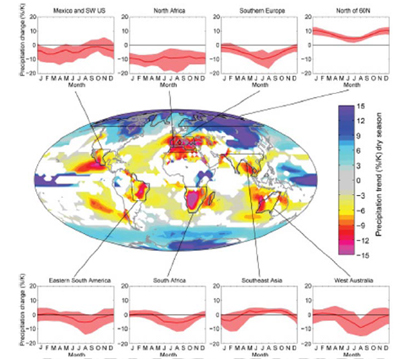|
|
Even if greenhouse gas emissions were to cease today, many of the forecast impacts of climate change are already irreversible for at least the next 1000 years, report researchers writing in the journal Proceedings of the National Academy of Sciences.
The study examine the consequences of allowing atmospheric carbon dioxide to build up to several different peak levels beyond current concentrations of 385 parts per million and then completely halting emissions. They found that certain climate impacts will be irreversible on a timescale exceeding next thousand years even if emissions are cut to zero.
“People have imagined that if we stopped emitting carbon dioxide the climate would go back to normal in 100 years, 200 years; that’s not true,” said lead author Susan Solomon, a scientist at of the National Oceanic and Atmospheric Administration’s Earth System Research Laboratory and a leading member of the International Panel on Climate Change (IPCC), said in a teleconference. “Climate change is slow, but it is unstoppable.”
Solomon and her co-authors Gian-Kasper Plattner, Reto Knutti, and Pierre Friedlingstein, focused on what they term “irreversible” climate impacts for which 3 criteria are met: “(1) observed changes are already occurring and there is evidence for anthropogenic contributions to these changes, (2) the phenomenon is based upon physical principles thought to be well understood, and (3) projections are available and are broadly robust across models.” These include “dry-season rainfall reductions in several regions comparable to those of the ‘dust bowl’ era” and “inexorable sea level rise” due to thermal expansion of seawater. The authors exclude impacts from melting of glaciers and ice sheets but note these could contribute “several meters” to sea level rise over the next millennium.
 Predicting future drought. Expected decadally averaged changes in the global distribution of precipitation per degree of warming (percentage of change in precipitation per degree of warming, relative to 1900–1950 as the baseline period) in the dry season at each grid point, based upon a suite of 22 AOGCMs for a midrange future scenario (A1B, see ref. 3). White is used where Inset plots. Red lines show the best estimate (median) of the changes in these regions, while the red shading indicates the +/- 1 likely range (i.e., 2 of 3 chances) across the models. Caption and image courtesy of PNAS. |
“Additional contributions to sea level rise from the melting of glaciers and polar ice sheets are too uncertain to quantify in the same way,” said Solomon. “They could be even larger but we just don’t have the same level of knowledge about those terms. We presented the minimum sea level rise that we can expect from well-understood physics, and we were surprised that it was so large.”
The authors did not factor in geoengineering schemes that could potential block sunlight or sequester massive amounts of carbon dioxide.
“Ideas about taking the carbon dioxide away after the world puts it in have been proposed, but right now those are very speculative,” said Solomon.
The authors conclude with a discussion of the policy implications of their research. They say the longevity of carbon dioxide in the atmosphere and the thermal inertia of oceans makes it imperative to address emissions sooner rather than later.
“It is sometimes imagined that slow processes such as climate changes pose small risks, on the basis of the assumption that a choice can always be made to quickly reduce emissions and thereby reverse any harm within a few years or decades,” the write. “We have shown that this assumption is incorrect for carbon dioxide emissions, because of the longevity of the atmospheric CO2 perturbation and ocean warming. Irreversible climate changes due to carbon dioxide emissions have already taken place, and future carbon dioxide emissions would imply further irreversible effects on the planet, with attendant long legacies for choices made by contemporary society.”
“In this paper we have quantified how societal decisions regarding carbon dioxide concentrations that have already occurred or could occur in the coming century imply irreversible dangers relating to climate change for some illustrative populations and regions. These and other dangers pose substantial challenges to humanity and nature, with a
magnitude that is directly linked to the peak level of carbon dioxide reached.”
S. Solomon et al. Irreversible climate change because of carbon dioxide emissions. PNAS Early Edition for the week of Jan 26, 2009